NEWS & MEMBERS ARTICLES
25 November 2025LEST WE FORGET
LEST WE FORGET
Jonathan SV Davies
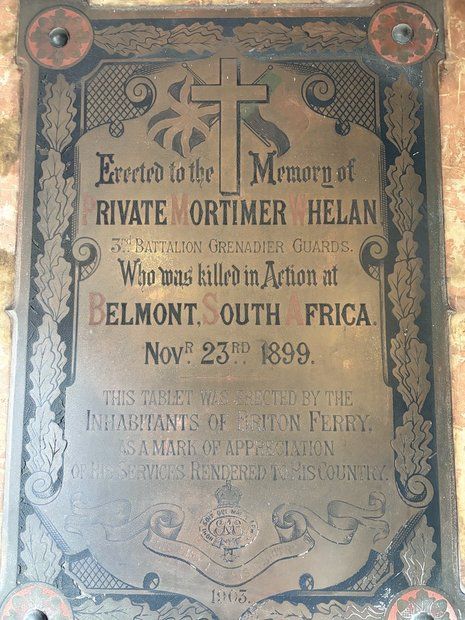
In recent weeks we have been reminded of the loss to families in the area from past conflicts. The expression ‘Lest we forget’ is at the forefront of our thoughts. Quite rightly, due to their extent, prominence at remembrance events in general has become focussed on the conflicts of World War One and World War Two. However, it may also at times be important to cast a light on other theatres of war, both old and new where the loss of life from the area has cast a shadow over local families. The family indicated here had a significant involvement in the Boer War.
How many people, I wonder, when entering Briton Ferry Library look up at the wall to the left and see the memorial placed to Private Mortimer Whelan of the 3rd Battalion Grenadier Guards. He fell during the Battle of Belmont in the Second Boer War on 23rd November 1899.
On deciding to erect a memorial to Mortimer Whelan there soon arose the question of where to site it. One possibility was to use his place of worship. However, Whelan was a Catholic and there was no church of that denomination in Briton Ferry at the time. The solution was to place the tablet in a prominent public building. The Cambrian newspaper stated on 2nd October 1902 ….
‘At the meeting of Briton Ferry District Council last Thursday, it was decided to give permission for a tablet to be placed in the Free Library to the memory of Pte. Mortimer Whelan (Grenadier Guards) who fell at Belmont. It appeared that although he was a Catholic, the latter had no place of worship in the town and the library was the only suitable public place.’
The unveiling was reported thus in the Evening Express on Monday 19th January 1903.
‘The ceremony of unveiling the tablet erected to the memory of Private Whelan at the public library, Briton Ferry, took place on Saturday afternoon in the presence of a large gathering. The chair was occupied by Mr H. Eccles and the ceremony of unveiling was performed by Mr D Davies, J.P. Among the speakers were Councillor Tudor Gwynne, Mr WD Jones, and the Rev. H Rees, curate-in-charge. The tablet bears the following inscription: - Erected to the memory of Private Mortimer Whelan, 3rd Battalion Grenadier Guards, who was killed at Belmont, South Africa, November 29, 1899. This tablet was erected by the inhabitants of Briton Ferry as a mark of esteem and appreciation. At the end of the inscription is the crest of the Grenadier Guards: - His life for is country.’
Mortimer Whelan was the son of William and Mary Whelan who were originally from Ireland. William worked in the Cape Copper Works in Briton Ferry. In the 1881 census, Mortimer is three years old and has four brothers and two sisters. The family lived in 19 Thomas Street, but by 1891 they had moved to 62 Regent Street.
On entering the Grenadier Guards, he was given the regimental number 7562. He joined on 1st August 1898 and is described as a tin worker. He would have been 20 and died just over a year later. The battle of Belmont was described as one where the British carried out little reconnaissance and the Boer’s followed their movements. It was caused by an attempt of Lord Metheun in command to relieve the siege of Kimberley. He sent the Guards Brigade on a night march to outflank the Boers, but due to faulty maps, the Grenadier Guards found themselves in front of the Boer position instead. Seventy Five men were killed during the action and 233 wounded; while the Boers had 83 killed, 20 wounded and 30 captured. Although described as a British victory, it was hardly glorious.
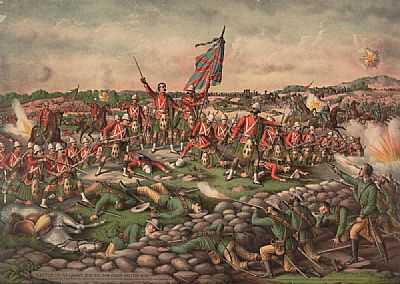 www.britishbattles.com
www.britishbattles.com
Battle of Belmont, 23rd November 1899
This, however, is not the end of the commitment by this family to the country since his brothers must also have enrolled. On 3rd August 1900 just nine months after the death of his brother the following letter was reported The Cambrian by Private Patrick Whelan.
A RELEASED PRISONER OF WAR
LETTER FROM A BRITON FERRY MAN
Irene, July 5th, 1900.
DEAR MOTHER, - I write you these few lines hoping you are all in the best of health. I am stationed for the time being at a place called Irene, eight miles south of Pretoria. There is about three hundred of us here, prisoners of war, helping to build a temporary bridge which have been blown up by the Boers. Now after having completed the construction, we are guarding it, and doing outpost duty on the surrounding hills at night. We are in a very bad predicament for the want of clothes, many of us walking about with our skin exposed. We feel the cold most acutely by night on outpost duty, when we got nothing to lie on but the bare veldt, doing our sentry on turns, and don't know the minute a bullet might come and lay us low, because the Boers are going about in batches, destroying the railways and everything they can get hold of. They do everything to impede the progress of the Britisher. I expect you would like to hear how we were treated at our place of imprisonment. The place was built with zinc, all open in front like a cattle shed. We had neither tables nor beds; we had two blankets given to us, but nothing to lie on but the bare ground. As far as food was concerned, it was nothing but slow starvation. Between fever and all, men were walking about like skeletons. There were 60 died in hospital, mostly of fever. I was very lucky to escape it. The man that slept next to me died of fever, and the one on the right was taken to the hospital in it. But what we had been patiently waiting for came at last - the boys in khaki to our relief. When they came in sight there rose such a shout from the prisoners that seemed to shake the ground that we stood on. So I must bring my letter to a close for the want of paper. Wishing you and all the family the happiness that is possible for this earth to afford. From your ever devoted son, PATRICK.
Eddie Whelan, Mortimer’s other brother, was wounded in action and arrived home at Briton Ferry to a hero’s welcome. These reports, both entitled ‘Home from the Front’ appeared in The Cambrian on 24th August 1900 and 7th September 1900 respectively;
Private Eddie Whelan, 9th Battery Field Artillery, has just arrived at Southampton from the front. He is a brother of poor Mortie [Mortimer] Whelan, who fell in the battle of Belmont, and also of Private Patsy [Patrick] Whelan, who was a prisoner of war at Pretoria, for many months. Private Eddie has been invalided home. He will make a short stay at Netley Hospital, and will proceed home to Briton Ferry. He should be cordially received on his return to Briton Ferry.
Private Eddie Whelan had a right royal reception on Monday evening. The Artillery Band met him at the station, and Mr Donovan was ready with a chair and a corps of willing bearers. Before the procession had gone half-way through Villiers Street, there were some two thousand followers. The spontaneity of the whole affair is a marvel and a mystery. At two o'clock the first intimation of his intended arrival was made known by Mr Humphreys who lost no time in seeing the bandmaster and making a few minor arrangements, which terminated in a brilliant demonstration of patriotic enthusiasm.
So, it seems we have a Briton Ferry family who were remembered and honoured at the time for the part they played in the Boer War. I feel it is incumbent on us not to forget.
19 October 2025Key to the Castle
THE KEY TO NEATH CASTLE
MARY WALKER
Whilst doing research about the history of Neath Castle, references to a key to the castle were found in newspaper articles.
It was intriguing to think about, was this an actual key, and if so, does it still exist?
Using British Newspaper Archives, references were found over some decades to the handing of a key from one Mayor to the next. This was part of the Mayor Making ceremony along with the wearing of the Mayoral robes and the bestowing of the title of ‘Constable of the Castle.’
These references to the ceremony occurred when Neath was part of the Borough Council (now the Neath Town Council).
In 1897, as part of the celebrations held in Neath to mark the Diamond Jubilee of Queen Victoria, Neath Castle ruins and grounds were presented to the Borough Council by Alderman JH Rowland.
In August of 1907 the Western Mail reported the grounds being formally opened by the mayor, a Mr Phillips. Intriguingly the article continues ‘Mr JR Jones (the chairman of the streets committee) presented the mayor with a handsome gold key and his worship then unlocked the gates.’
The mayor gave a speech which ended with hopes that care would be taken of the castle and its grounds. The castle and grounds would be open to the public, for the present on Sunday and Thursday afternoon and evenings.
A report under the title ‘Golden Key of Neath Castle’ which appeared in the Herald of Wales (November 1921) reported on the investiture of Alderman Hopkin Morgan with ‘the Mayoral robes, chain of office, together with the golden key of Neath Castle, for the fourth time.’
This photograph in the South Wales Evening Post of 10th November 1934 shows the handing of the key from the outgoing Mayor to the new Mayor, Councillor T Cole.
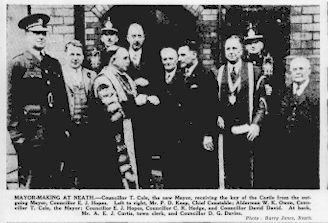
South Wales Evening Post - 10th November 1934
A later report on 10th November 1936 in the Western Mail & South Wales News describes the presentation of the ‘gold key to Neath Castle which forms part of the insignia of the borough’. The castle itself is described as ‘long being in ruins and hidden behind rows of small houses’ [Castle Street], although the key was presumably in a better condition.
Following the timeline of these articles it was fascinating to see changes in social attitudes: the rise and fall of political parties, women being featured in the reports, and finally even elected as Mayor. The first woman to be elected Mayor of Neath was Hilda Howells in 1964, closely followed by Mary Moule the following year. However, it was not until 1986 that the third woman was appointed Mayor, being Mrs Iris Hobbs.
It was Mrs Hobbs who provides us with our final definite record of the key, when she handed it over to the incoming Mayor for 1987-88, Mr Harold Thomas. Photographed for the Neath Guardian of 29th May 1987, the key is seen in a handsome presentation box and we are told that ‘the presentation of the key is a traditional feature of the installation of the new Mayor of Neath’.
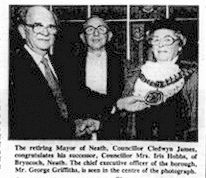
South Wales Evening Post - 21st May 1986
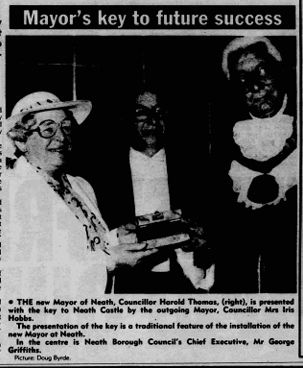
Neath Guardian – 29th May 1987
(This photograph was the only one found that actually features the key)
So, where is the key now?
This is a fascinating question, and one for which there is an answer. After contacting Neath Town Council, the Town Clerk was able to confirm that the key existed and was with Neath Town memorabilia. The author being given permission to view the key.
As in the last newspaper photograph, it is kept in a presentation box of blue ‘leather’. The key looks worn, but the wording on both sides is visible. The coin or medal in the middle has wording on both sides. On the ‘front’ can be read SIGILLVM COME VILLA DE NETH surrounding images of a double turreted tower and buildings. This is a close variant of the motto that appears on the common seal of Neath that can be seen above the entrance to Neath General Market.
The ‘reverse’ side is inscribed ‘Neath Old Castle Key handed to ES Phillips Esq. Mayor of Neath at the opening ceremony on 1st August 1907 and to be passed down to his successors in the Mayoralty’.
The name of Davies & Sons Jewellers Neath appears on the blue velvet lining of the box.
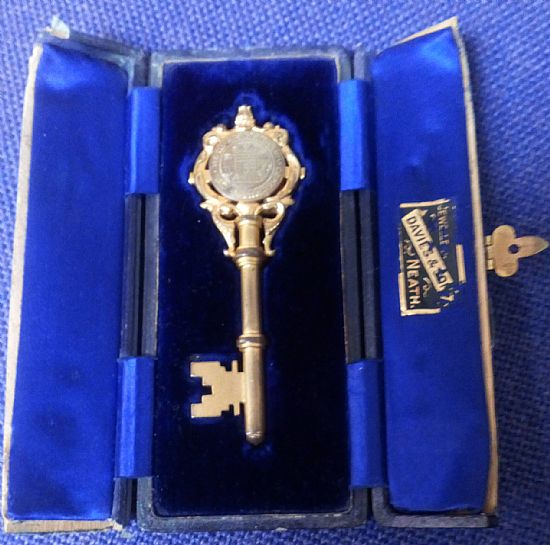
The key to the castle in its box
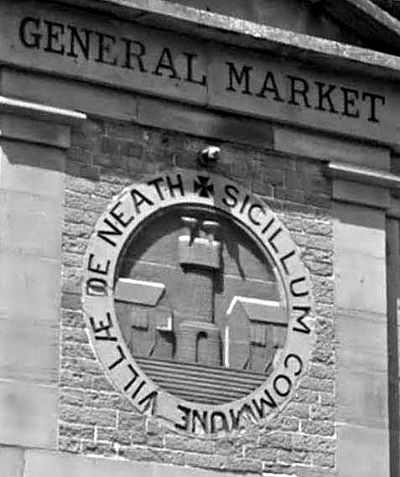
Market Entrance
Finally, it seems that the key has not been used as part of the Mayor Making Ceremony in Neath for some time, but perhaps following this interest it may return to become part of this traditional ceremony.
Note
Naturally, the castle itself would not have had a door opened by a key. This gold-plated ceremonial key was quite possibly capable of opening the gated entrance to the castle grounds that stood in Castle Street on the right of the Wesley Chapel (Moose Hall). It is unlikely to fit the gate in the railings that were installed later and that still exist today.
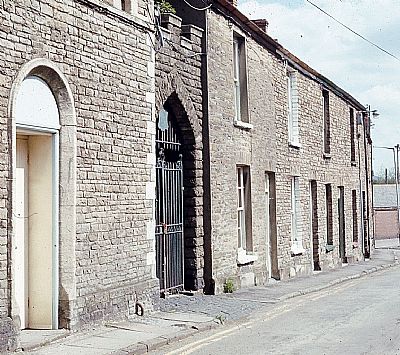
Entrance gates to Neath Castle and grounds in Castle Street c.1960s

